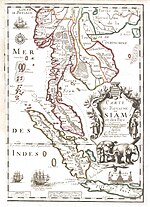Draft:Chin Lin
Chin Lin/Kim Lin (金鄰/金邻国) (จินหลิน/กิมหลิน) | |||||||||
|---|---|---|---|---|---|---|---|---|---|
| 9 CE–c. 6th century CE | |||||||||
 Territory of Tun Sun (1st-6th centuries CE) and the neighbors, proposed by Lawrence Palmer Briggs in 1950. | |||||||||
| Capital | Mueang Uthong | ||||||||
| Religion |
| ||||||||
| Historical era | 9 CE -6th centuries CE | ||||||||
• Established | 9 CE | ||||||||
• Disestablished | c. 6th century CE | ||||||||
| |||||||||
| Today part of | |||||||||
| History of Thailand |
|---|
 |
|
|
Chin Lin or Kim Lin (Chinese: 金鄰/金邻; Thai: จินหลิน/กิมหลิน) was an ancient Mon political entities in modern lower central Thailand.[1]: 27
In the 3rd century CE, after defeating Tun Sun to control the trans-Kra Isthmus trade route and encircle Chin Lin,[1]: 20, 25 [2]: 258 king Fan Man of Funan attempted to sieze Chin Lin,[1]: 20 but failed due to his illness.[3]: 258 [2]: 269
After the fall of Funan in the mid-6th century, Chin-Lin together with the northern part of Tun Sun and other inhabitants in the present-Tanintharyi Region evolved into Dvaravati and its colony, Lavo Kingdom.[2]: 268–270
Location[edit]
The location of Chin Lin remains unclear. It was first mentioned around 9 – 22 CE during the late Western Han period, a Chinese emperor Wang Mang sent an embassy to visit Chin-lin. Later in the 3rd century, Chin Lin was again mentioned in the account of Funan king Fan Shih-man's conquests in the Chinese text Liáng Shū, which states that Chin Lin was located 3,000 li north of the kingdoms of Ta-k'un (Ch'ü-tu-k'un) and Chü-li (Chiu-chih),[2]: 258 speculated to be Kou-chih of Kole polis in present-day near Kuantan of Malaysia.[1]: 26–27 Palmer Briggs proposes that Chin-lin and its southern neighbor, Tun Sun, was the Mon countries. The boundary between this two entities was ill-defined, but probably not far above the present-Mergui-Tanintharyi Region.[2]: 259
It located in the ancient region of Rāmanyadesa (lit. countries of the Rāman, also known as the Mon people).
Citations[edit]
Notes[edit]
References[edit]
- ^ a b c d e Paul Wheatley (1956). "Tun-Sun (頓 遜)". The Journal of the Royal Asiatic Society of Great Britain and Ireland. Cambridge University Press: 17–30. Archived from the original on 26 April 2024.
- ^ a b c d e Lawrence Palmer Briggs (1950). "The Khmer Empire and the Malay Peninsula". The Far Eastern Quarterly. 9 (3). Duke University Press: 256–305. doi:10.2307/2049556. Archived from the original on 26 April 2024.
- ^ Gustaaf Schlegel (1899). "Geographical Notes. VII. Tun-Sun 頓遜 or Tian-Sun 典遜 Tĕnasserim or Tānah-Sāri". T'oung Pao. 10 (1). Brill Publishers. Archived from the original on 26 April 2024.
